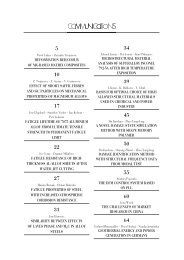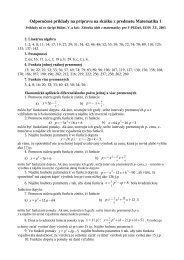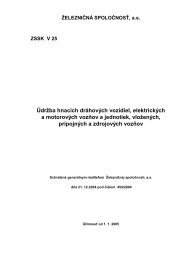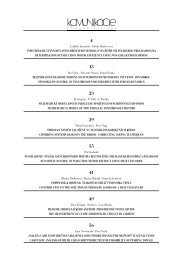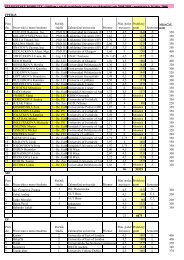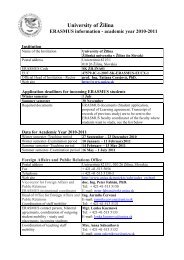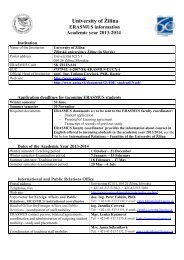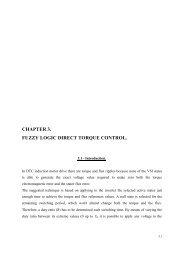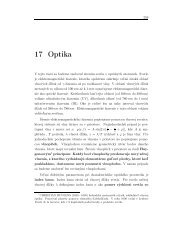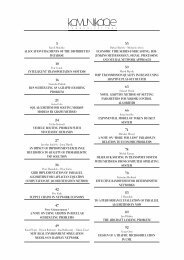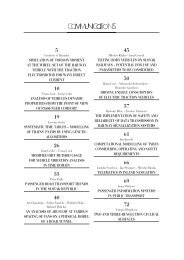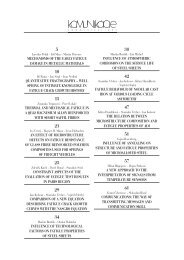posudzovanie vplyvu automobilovej dopravy na ... - Žilinská univerzita
posudzovanie vplyvu automobilovej dopravy na ... - Žilinská univerzita
posudzovanie vplyvu automobilovej dopravy na ... - Žilinská univerzita
You also want an ePaper? Increase the reach of your titles
YUMPU automatically turns print PDFs into web optimized ePapers that Google loves.
C O M M U N I C A T I O N S<br />
I S<br />
Obr. 3 Hustý porast<br />
Fig. 3 Dense greenery<br />
Obr. 4 List<strong>na</strong>tý porast<br />
Fig. 4 Deciduous greenery<br />
Obr. 5 Zmiešaný porast<br />
Fig. 5 Mixed greenery<br />
Krovitý list<strong>na</strong>tý hustý porast šírky 5 m (obr. 3) spôsobuje<br />
redukciu rozptylu škodlivín do okolia asi 20 %. Porast šírky 10 m<br />
(obr. 4) spôsobuje v lete redukciu rozptylu škodlivín až 60 %. Najvhodnejšia<br />
je kombinácia list<strong>na</strong>tých a ihlič<strong>na</strong>tých stromov. Nie sú<br />
výkyvy v účinnosti výsadby v lete a v zime (obr. 5) [3].<br />
Pri list<strong>na</strong>tých a ihlič<strong>na</strong>tých stromoch sa prejavuje zachytávanie<br />
prachu produkciou kyslíka a spotrebou kysličníka uhličitého. Pri<br />
plynných exhalátoch je účinok zelene len pri malých koncentráciách.<br />
V opačnom prípade dochádza k vysýchaniu hlavne ihlič<strong>na</strong>tých<br />
stromov.<br />
Z uvedených porov<strong>na</strong>ní vyplýva, že problematiku dopadu<br />
<strong>dopravy</strong> <strong>na</strong> znečistenie ovzdušia v mestách je potrebné riešiť už<br />
<strong>na</strong> úrovni územnoplánovacej dokumentácie, kde sa rozhoduje<br />
o umiestnení komunikácií.<br />
Potreba rovnováhy civilizačnej<br />
a biologickej zložky človeka<br />
sa výraznejšie prejavuje v mestskom<br />
intraviláne, kde sa <strong>na</strong> zhoršovaní<br />
životného prostredia podieľa<br />
aj automobilová doprava.<br />
V intraviláne miest je citlivo<br />
vnímaný aj hluk od <strong>dopravy</strong>.<br />
Zeleň popri komunikácii tlmí<br />
hluk od <strong>dopravy</strong> v závislosti od<br />
Obr. 6 Vplyv šírky zelene <strong>na</strong> redukciu imisií<br />
Fig. 6 The influence of the green belt on emission reduction<br />
A bushy, dense deciduous greenery with the width of 5 m (see<br />
Fig. 3) reduces the dispersion of the pollutants to the surrounding<br />
by approximately 20 %. The greenery with the width of 10 m (see<br />
Fig. 4) reduces the dispersion of the pollutants by up to 60 % in<br />
the summer. The most proper is the combi<strong>na</strong>tion of deciduous<br />
and coniferous species. There is no oscillation in the efficiency of<br />
the planting between summer and winter (see Fig. 5) [3].<br />
The effect of capturing the dust by oxygen production and<br />
carbon dioxide consumption can be seen in deciduous and coniferous<br />
trees. Considering gaseous pollutants, greenery is effective<br />
only in case of low concentrations, otherwise coniferous trees in<br />
particular dry up.<br />
It can be seen from the presented comparisons that the question<br />
of the impact of traffic on air pollution in urban agglomerations<br />
should be solved already at the stage of land planning<br />
documentation, where the location<br />
of the roads is determined.<br />
The need of the balance between<br />
civilization and biological aspects of<br />
man is manifested especially in urban<br />
agglomerations, where automobile<br />
traffic makes the environment worse.<br />
The noise from the traffic is felt<br />
as a sensitive issue in urban agglomerations.<br />
The greenery mutes this<br />
noise depending on the width of the<br />
green belt. More significant muting<br />
8<br />
● KOMUNIKÁCIE / COMMUNICATIONS 1/2003



